Marketing jargon might seem complicated, but it doesn’t have to be. Instead of a list of long-winded marketing term explanations, we’ve created easy-to-understand definitions for the most popular marketing jargon used today. Let’s get started.
Marketing jargon by categories
Before we jump right into these terms, we wanted to give a little context. We’ve broken down our comprehensive list into categories relating to when and where these marketing terms are most commonly used. As you continue reading, you’ll begin learning more about:
- Beginner marketing terms
- B2B marketing terms
- Digital marketing terms
- Marketing terms for referral programs
These categories are intended to make more sense of the many marketing terms you’ll see below. We also recommend bookmarking this page so that you can revisit whenever you need to in the future. Let’s begin by looking at basic marketing jargon.
Basic marketing terms for beginners
Everyone who enters the world of marketing must start somewhere. Before you delve too deep into advanced marketing jargon, it’s a good idea to understand basic terms. Here are explanations of common marketing terms for beginners.
Advocate marketing – Involves a brand creating affinity or a deep affection among its customers. Apple is a great example of a company known for its strong brand advocates.
Affiliate marketing – A type of marketing that rewards third-parties for sending traffic that results in a company achieving new sales or sign-ups.
Bottom-of-the-funnel marketing – These are marketing efforts aimed at leads who are near or in the final purchasing stage. Bottom-of-the-funnel marketing strategies often include free trials and product demonstrations.
Buyer persona – A general representation of a company’s ideal customer, inclusive of specific behaviors, lifestyle choices, and other types of information based on market research and data.
CRM – This stands for customer relationship management, which involves all aspects of companies interacting with customers. Examples of this include accurately managing contact lists, interacting with customers, and other tasks focusing on increasing customer growth.
CTA (call to action) – Calls to action are ways for marketers to encourage an audience to take some specific type of action. This action can involve making a purchase, downloading a software demo, signing up for an email list, or something similar.
Source: CoSchedule
Growth hacking – Don’t worry, this is a type of growth marketing that doesn’t involve anything unethical. Growth hacking is simply a term for methods used to help a company grow in a short amount of time without excessive marketing spend. If someone can execute these strategies, they’re usually part of a company’s growth team.
Marketing automation – Marketing automation involves the use of software to automatically create and carry out marketing strategies. This software can either be managed in-house or outsourced by partnering with another business.
Middle-of-the-funnel – This is an area of the marketing funnel containing buyers with lots of interest. They are already familiar with your product or service, and are likely thinking of making a purchase. However, middle-of-the-funnel individuals need more details and convincing before moving down the funnel.
Top-of-the-funnel – This area of the marketing funnel focuses on efforts to generate leads and build initial interest in a product, service, or company. Top-of-the-funnel marketing is where general information is shared, with things getting more in-depth as someone moves down the funnel.
Word-of-mouth marketing – Word-of-mouth marketing takes place when people inform others about how much they love your business.
B2B marketing terms
If your business sells its products and/or services to other companies, you’re in the B2B (business-to-business) industry. Anyone who works in this industry knows it comes with a lot of specific marketing terms not used when marketing to a broader consumer base. Let’s take a closer look at the most used B2B marketing jargon.
Account-based marketing – Utilized by many B2B companies, this involves personalizing your approach or technique for each of your B2B clients or accounts.
Source: Neil Patel
Inbound marketing – This type of marketing involves having leads come to a company. Popular methods to gain inbound leads include social media marketing, content marketing, email marketing, and SEO.
Lead – Another term for someone who expresses potential interest in becoming a customer of your company.
Lead generation – This is the process of attracting and bringing in new individuals who might end up becoming customers. There are many ways to generate leads including content, email, social media, and referral marketing.
Lead nurturing – A term for the process of building relationships with potential customers. There are many ways to nurture leads including re-targeting, sending a follow-up email, making a follow-up phone call, and sending a message on social media.
MQL (marketing qualified lead) – An MQL is a qualified lead that’s potentially ready to buy. This is the first stage in the sales funnel, and happens before a lead becomes an SQL (sales qualified lead).
Outbound marketing – Unlike its inbound counterpart, outbound marketing requires employees to seek out and convert prospects and leads. This often includes cold calling, emailing and visiting leads in attempts to gain their business.
Prospect – Someone interested in becoming a customer, but isn’t yet ready to make a purchase. Unlike a lead, prospects are those who have been qualified (usually by a marketing or sales team) as more serious potential buyers. Finding prospects is important because it helps companies avoid wasting time with unqualified leads.
SQL (sales qualified lead) – This is an abbreviated term given to a lead with the means and ability to purchase your products or services. Many companies do this by utilizing lead scoring, which is to evaluate how often leads interact with your company. Generally, the leads who spend the most time talking to your employees and/or interacting with your website are more likely to become prospects.
Digital marketing jargon
Now more than ever, companies are executing digital strategies with stellar results. With that said, digital marketing is full of terms and abbreviations that can leave anyone scratching their head in confusion. Here is a breakdown of several popular digital marketing terms.
Backlinking – This is the process of creating a digital link that goes from one website to another one. External linking connects one website to others, while internal linking occurs when a website links to another page of its own website.
Conversion rate – After a website visitor completes the action a company wants them to do, it results in a conversion. A conversion rate is the basic equation used to calculate the chances or odds of this happening. It ultimately points to the success or failure of a marketing program.
[su_icon_text color=”#474747″ icon=”icon: lightbulb-o” icon_color=”#0088cc”]Example: If a company converts 10 out of 100 visitors, its campaign has a 10% conversion rate.[/su_icon_text]CPC (cost-per-click) – This number represents how much is spent each time a visitor clicks through to a specific website. The formula takes into account the total money spent divided by number of clicks.
Source: Online Advertising Guide
Keywords – This is a term given to any word or combination of words someone types when entering a query or search into a search engine. Learning about keywords gives marketers vital information about the popularity (search volume) of search terms.
PPC (pay-per-click) – This is a type of paid advertising method where companies pay for ad placements on other websites. The ad is created to best attract readers to click through, with the goal receiving increased traffic.
SaaS (software as a service): The SaaS acronym is a business and delivery model in which software is offered to customers on a subscription basis. It’s sometimes referred to as “on-demand software” and provides specific services. For example, Dropbox provides cloud storage, Mailchimp serves as an email marketing platform, and Slack offers communication channels.
SEO (search engine optimization): Search engine optimization involves using a combination of strategies to position a website higher in search results. SEO is divided into two main categories: on-page and off-page. On-page SEO involves what website visitors see and off-page SEO focuses more on backlinking.
SERPs (search engine results pages): When someone types a keyword into a search engine, they’ll be sent to SERPs. This is a search engine’s way of categorizing crawled websites.
UX (user experience): In the world of digital marketing, user experience starts the minute someone visits a website. A website’s speed, features, layout, landing pages, and other factors all play into giving a user the best possible web browsing experience.
Marketing terms for referral programs
Whether you work in a marketing-related position or just want to learn more about it, it’s essential to take a moment and learn more about referrals. Here’s more information about commonly utilized referral marketing terms.
Incentives: Incentives are popular ways for companies to entice referrals from customers. These can come in the form of discounts, free products, and other types of rewards.
Partner programs: These are partnerships where one company joins with another company to mutually promote one another’s products, services, or marketing efforts.
Referral marketing: One of the best proven and time-tested marketing methods. Referral marketing is based on referrals, which is when someone refers or recommends your business to another person or company. For B2C companies, referrals often come from customers. On the other hand, B2B referrals often come from other businesses. Referral marketing incentives can include free products, discounts, and rewards points. If you want to begin automating this process, consider using referral marketing software.
Referrer: Someone in a referral program who refers your company to others. When your company asks for referrals, this is the type of person you’re targeting.
Referral: A referral is a person who receives a recommendation from a referrer (see above). If everything goes right, the referee eventually becomes a new customer.
[su_icon_text color=”#474747″ icon=”icon: lightbulb-o” icon_color=”#0088cc”]Wanting to know more about referral marketing? For in-depth explanations of a wide range of referral marketing terms, don’t miss our Glossary of Referral Program Terms to Remember.[/su_icon_text]Conclusion
Hopefully, we’ve simplified lots of marketing jargon for you, and you’ve learned quite a bit. If you’re looking for more information about marketing, visit our Types of Marketing Strategies Hub.








